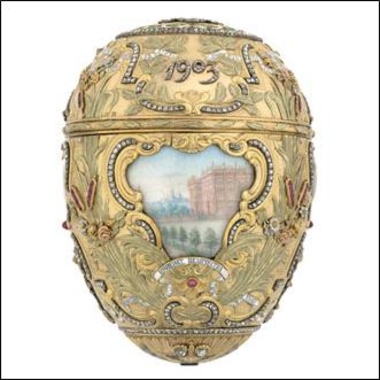"Fabergé: Jeweler to the Tsars" coming to OKCMOA in 2015

Oklahoma City - More than 230 rare and storied treasures created by the House of Fabergé will be celebrated in a new exhibition at the Oklahoma City Museum of Art. "Fabergé: Jeweler to the Tsars" will be on view from June 20 through September 27, 2015. The exhibition, drawn from the Collection of the Virginia Museum of Fine Arts, Richmond, will showcase Carl Fabergé's fine craftsmanship in pieces of jewelry and adornments once belonging to the Russian Imperial family.
"This exhibition represents a double honor for the Oklahoma City Museum of Art-the opportunity to collaborate with the Virginia Museum of Fine Arts and to showcase the largest Fabergé collection outside of Russia," said E. Michael Whittington, OKCMOA President and CEO. "The technical and artistic virtuosity of the Fabergé workshop is without parallel. Individually, these objects are breathtaking. Collectively, they represent a unique window into an empire and subsequent revolution that dramatically altered 20thcentury history. We are proud to present such an extraordinary collection of treasures to our community."
From dazzling Imperial Easter eggs to delicate flower ornaments and from enchanting animal sculptures to cigarette cases, photograph frames and desk clocks, Fabergé often turned the most mundane objects into miniature works of art. The vast majority of his designs were never repeated, and most pieces were made entirely by hand. The success of his business was inextricably linked to the patronage of the Romanov dynasty and the close ties among the British, Danish and Russian royal families, who often exchanged works by Fabergé as personal gifts.
The "Imperial Tsesarevich Easter Egg" of 1912, which will be on view at OKCMOA, was a gift to Empress Alexandra from her husband, Emperor Nicholas II. The egg commemorates their son, Alexsei, who nearly died the previous year of hemophilia. For the shell, craftsmen joined six wedges of highly prized lapis lazuli and hid the seams with an elaborate gold filigree encasement. Inside the egg, a diamond encrusted Romanov family crest frames a two-sided portrait of the young child.
These objects were associated with refinement and luxury because the House of Fabergé was known for accepting nothing less than perfection as well as for being business savvy. Beyond the elegant showrooms in Moscow and Saint Petersburg, hundreds of the country's finest goldsmiths, enamellers, stone carvers, gem cutters and jewelers were at work creating innovative and complex designs that could not be readily imitated.
The presence of the Romanov family - Emperor Nicholas II, Empress Alexandra and their five children - is most intimately felt in the exhibition through the display of more than 40 family photographs held in enameled Fabergé frames. These family photographs and jewels were some of the only possessions the Romanovs took with them when they were forced out of St. Petersburg during the Revolution. In an effort to preserve their wealth, the Romanov daughters are said to have sewn Fabergé jewels into their undergarments. In the end, their diamond-lined corsets managed to prolong their execution and sealed the fate for the inevitable fall of the dynasty.
About Oklahoma City Museum of Art
Accredited by the American Alliance of Museums, the Oklahoma City Museum of Art serves more than 135,000 visitors annually from all 50 states and more than 30 foreign countries and presents exhibitions drawn from throughout the world. The Museum's collection covers a period of five centuries with highlights in European and American art from the 19th and 20th centuries, a growing collection of contemporary art, and a comprehensive collection of glass sculpture by Dale Chihuly. The Museum boasts the region's premiere repertory cinema, which screens the finest international, independent, and classic films, and is home to the Museum School, which offers classes for students of all ages as well as art camps for children. Amenities include the Museum Store, a roof terrace, and the Museum Cafe, a full-service restaurant, offering lunch, dinner, Sunday brunch, afternoon tea, a full bar, and catering services. For more information visit www.okcmoa.com.
The Gayly – June 25, 2014 @ 11am





